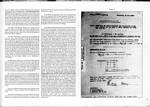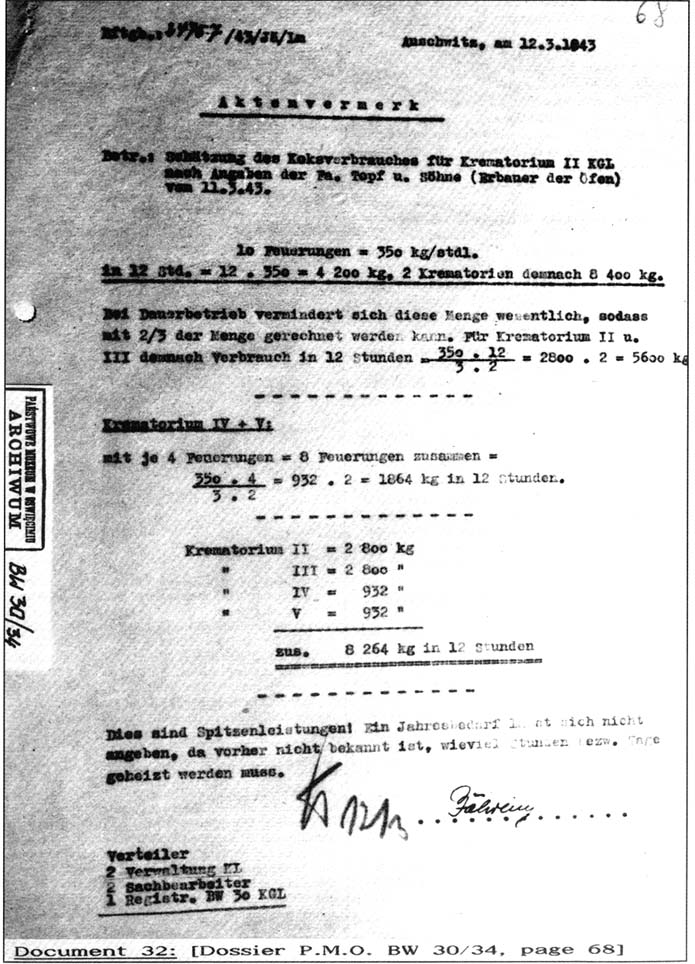|
|
 |
 |
AUSCHWITZ:
Technique
and Operation
of
the Gas Chambers © | |
|
| |
 |
Back |
 |
Contents |
Page 223 |
 |
Home
Page |
Forward |
 |
| |
silos, etc), together with the associated components (fans,
valves, and cocks) and, of course, incineration furnaces, they did
not manufacture gas detectors, objects associated with systems
totally foreign to their spheres of activity, so they must
necessarily have had to order them from another civilian firm. Why
did this SS use Topf an intermediary instead of directly approaching
a specialist supplier? The answer must be that in this was they
avoided awkward questions or the putting of two and two together
that might have occured if some civilian firm not knowing the
special activity of the Auschwitz camp had received such an order.
On the other hand there were no such worries in dealing with Prüfer,
who was after all technical advisor for the Krematorien.
From 26th to 28th February, Messing was working on the air
extraction ducting of Leichenkeller 2 (the future undressing room),
which was in the form of a metal tube twenty centimeters or so in
diameter running the whole length of the room [see the drawing by
David Olère. Part II Chapter 6].
On Friday 27th
February. following the letter concerning the weak state of the
prisoners detailed to worksites 30 and 30a, the Bauleitung informed
the camp labor service that this commando, since it could not be
employed on worksite 30, had been sent to 30b (Krematorium IV),
probably to do simple handling jobs better suited to their physical
condition, and requested that the number of prisoners be increased
and the commando be ready to work on both sites 30 and 30a, the nest
day. On the same day, the Bauleitung sent to Messrs Topf its
requests for the release of metal parts for the ventilation and air
extraction installations and for the forced draught system for
Krematorium II, asking Topf to specify the needs more precisely,
naturally as a matter of urgency. In addition the Bauleitung
informed Industrie Bau AG that work on the roof of Krematorium II
should be commenced immediately, the cost being estimated by the
Bauleitung at 9,418.04 RM.
On 28th February, following a
conversation with Prüfer, Jährling wrote out the Bauleitung's firm
orders for two electric corpse lifts (one for Kr II, the other for
III, to be used to raise the corpses from the basement morgues to
the level of the furnace room on the ground floor) for a total of
18,742 RM (9,371 each), fitted with a transport cage 1.80 meters
long, 1.35 wide and 2.10 high. This was in addition to a Demag goods
hoist of 1,500 kg capacity at a price of 968 RM, to be delivered
immediately to temporarily equip Krematorium II.
On 1st
March. the contract for the roof of Krematorium III was awarded to
Industrie Bau AG, on the basis of its tender of 27th February (drawn
up by the Bauleitung!) for a sum of 9,418.04 RM. On the same day,
Huta transmitted to its foreman at Auschwitz, Herr Stephan, Sheet 11
[see annex] of Project 7015/IV (Krematorien II and III) drawn that
day and concerning the ceiling supporting beam and cross beams of
the waste incinerator room (probably of Krematorium III, for this
was modified with respect to Krematorium II, the annex wing being
made longer).
From 1st to 7th March, Messing worked pro the
ventilation system of Leichenkeller I (future gas chamber) which he
brought into service on 7th.
On 3rd March, the Bauleitung
sent to Industrie Bau AG a release request form for iron to be
filled immediately. This was for 25 Kg required for the additional 2
meters of roof on the southern wing of Krematorium III and was on
top of the request for 800 kg already made for the roof as a whole.
On 5th March, the Bauleitung ordered from the metalworking
shop of the Auschwitz DAW [German Equipment Workshops] 1 St[ü]ck
Handgriff für Gastür Ø 12 / 1 handle for gas [tight] door, 12 [mm]
diameter for Birkenau Krematorium II. The order was received on 6th
March and completed on 10th. This was not an ordinary door handle,
but a metal bar 20 to 30 cm long, riveted at each end and fitted
horizontally on the door to facilitate its handling.
On 6th
March, the Bauleitung ordered from the DAW metalworking and wood
working shops "one gas [tight] door, 100 [cm wide] by 192 [cm high]
for Leichenkeller 1 of Krematorium III, BW 30a, to be made on the
same pattern as dimensions as the cellar door of the Krematorium
opposite [II] with a 8 mm double glass peep-hole, with rubber
sealing strip and fittings". The door had still not been made by
31st March. This order proves that the Leichenkeller 1 of
Krematorien II and III were filled with gas tight doors [see this
extract from a letter of 31st March 1943, Part II, Chapter 8,
"Criminal traces"]. The same day, the Bauleitung sent a letter to
Messrs Topf, written by Jährling and signed by Bischoff, agreeing to
the written suggestion (by Prüfer) [this has not been found, and was
probably destroyed because it discussed the project in "too
realistic" terms] that the CORPSE CELLAR [LEICHENKELLER] 1 SHOULD BE
PREHEATED with the hot air coming from the three small rooms housing
the motors for the forced draught installation [Document 30]. This
installation, driven by those 15 HP (11 kW) motors driving the three
fans drawing the flue gases from the furnaces to the chimney,
produced a lot of heat, and neither the SS nor Prüfer had planned
any way of dissipating it. It is more than likely that it was again
Prüfer who had the bright idea of getting around this problem by
channeling the unwanted heat to the Leichenkeller 1, where heat was
required to bring the temperature of the room up as quickly as
possible to 25 or 30 degrees centigrade (the temperature of
evaporation of hydrocyanic acid being 26-27° C). If the gas chamber
were to be preheated, the toxic effect would be instantaneous,
producing a "flash" death. Prüfer, while claiming at act our of
"humanity" towards the poor Jews, was doing everything in his power
to push firm's sales, on which he got a commission of 2%. In the
author 's opinion, this letter is one of the most vital elements in
proving the existence of a homicidal gas chamber in Leichenkeller 1
of Krematorium II. Otherwise it is incomprehensible and absurd that
there should be plans to heat a morgue, a place that by definition
should be kept cool. Furthermore. one cellar of Krematorium III I
formally designated an "Auskleideraum / Undressing room". The letter
does not specify which cellar, but Messing, in his timesheets,
indicates it precisely: "Auskleidekeller II / undressing cellar II
[for 2]". Thus, this document contains two damning "slips",
important indirect proofs demonstrating the "abnormality" of the
Leichenkeller: Leichenkeller 1 can no longer be an underground
morgue because there are plans to "preheat" it; Leichenkeller 2 can
no longer be a morgue because it has become a place where people get
undressed. However, before Prüfer's bright idea could be put into
practice, one of the forced draught motors caught fire, damaging the
installation. This fire caused the system to be withdrawn from
service in Krematorium II and totally abandoned in Krematorium III.
Natural draught was henceforth used in all four Krematorien, which
meant lost commission of several hundred Reichsmark for Prüfer and
the impossibility of preheating the Leichenkeller 1. |
|
| Document 32 |
 | |
| |
AUSCHWITZ:
Technique
and operation
of the gas chambers
Jean-Claude Pressac
© 1989, The
Beate Klarsfeld Foundation |
 |
Back |
Page 223 |
Forward |
 |
|

